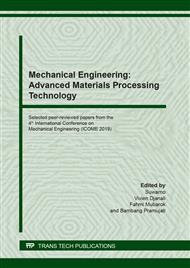p.166
p.172
p.182
p.188
p.196
p.204
p.213
p.218
p.224
Macro-Micro Analysis on 2-Layer Semiautomatic MIG Welding of AA5052 Material Using ER5356 Electrode
Abstract:
Lightweight structures have widely been used due to their weight saving. Aluminum alloys are among the alternative for their material, and they are mostly manufactured by employing welding process using the same filler material as the base metal. Aluminum welding process can be conducted employing 2-layer semiautomatic MIG when the thickness of the plate is no more than 5 mm. Porosity in aluminum alloy welding is considerably difficult to avoid due to hydrogen and oxygen environment. Macro-micro analyses on 2-layer semiautomatic MIG welding of AA5052 material using ER5356 electrode have been carried out. A pair of AA5052 plates of 400 mm x 75 mm x 5 mm were clamped at three points of one side and welded using 2-layer semiautomatic MIG welding using ER5356 filler such that angular distortion can happen. Welding speed of 6, 7, and 8 mm/s using electrical voltage of 23 Volt, current of 130 Ampere, filler diameter of 0.8 mm, and shielded using argon gas. After completion of the welding, angular distortion was measured using dial indicator possessing accuracy of 0.01 mm. Welding result was micro-Vickers (VHN0.1) hardness, tension and Charpy impact, as well as micro structure using OM and SEM-EDS. The highest tensile strength was found at welding speed of 7 mm/s, angular distortion of 6.780, average VHN0.1 of the BM, HAZ, and WM of 47.82, 49.14, and 51.75, respectively. Tensile strength of 156.5 MPa and joint efficiency of 70%, BM failure strain of 17%, Charpy impact of 0.26 J/mm2. SEM-EDX at spot shows that the amount of Mg is not significant for being Al2Mg3 precipitate such that Vickers hardness distribution do not show any difference among BM, HAZ, and WM.
Info:
Periodical:
Pages:
204-212
Citation:
Online since:
October 2020
Keywords:
Price:
Сopyright:
© 2020 Trans Tech Publications Ltd. All Rights Reserved
Share:
Citation:


